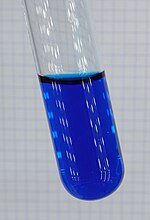Cobalt(II) cyanate is the hypothetical inorganic compound with the formula Co(OCN)2.
The simple cobalt(II) cyanate has not been proven to be made. However, the tetraisocyanatocobalt(II) ion (Co(NCO)42-) is known and its blue color and is used as a qualitative test for cobalt(II) ions.
History
Cobalt(II) cyanate was claimed to have been produced in 1952 by carefully heating pyridine cobalt(II) cyanate under vacuum. The nature of the compound produced has not been elucidated by X-ray diffraction.[1]
In contrast, the tetraisocyanatocobalt(II) ion (Co(NCO)42-) has been identified by X-ray crystallography and is widely known.[2] After being first produced in 1871, it has been used as a qualitative test for cobalt(II).[3]
Other cyanate complexes of cobalt have been discovered, such as tetrakis(pyridine)cobalt(II) cyanate.[4]
Complexes
Tetracyanatocobaltate(II)

Multiple compounds of the related tetracyanatocobaltate(II) has been structurally elucidated, such as [Co(C5H5)2]2[Co(NCO)4]. All of these complexes have an intense blue color.[2][5]
Potassium tetraisocyanatocobaltate(II) has been produced by the reaction of potassium cyanate and cobalt(II) nitrate:[6]
- 4 KOCN + Co(NO3)2 → K2[Co(NCO)4] + 2 KNO3
Tetracyanatocobaltate(II) salts with other counterions, such as cobaltcenium [Co(C5H5)]+ and EMIM are known.[2]
Other adducts
Cobalt(II) cyanate complexes have been produced by the addition of potassium cyanate to a soluble cobalt salt, such as cobalt(II) chloride, followed by the addition of the complexing agent, such as pyridine, bipyridine,[7] quinoline, and 2,6-dimethylpyrazine.[8]
Structure
Although the simple cyanate is unknown, the structure of the tetracyanatocobaltate(II) ion has been elucidated. The [Co(NCO)4]2- ion consists of a nitrogen-bonded tetrahederal central cobalt atom. The cobalt-nitrogen bond length is about 1.96 Å.[2]
References
- ^ Albert V. Logan; David C. Bush; Charles J. Rogers (1952). "The Heats of Formation of Cobalt(II) and Nickel(II) Pyridinated Cyanates and Thiocyanates". Journal of the American Chemical Society. 74 (16): 4194–4195. doi:10.1021/ja01136a069.
- ^ a b c d Tim Peppel; Alexander Hinz; Philipp Thiele; Monika Geppert-Rybczyńska; Jochen K. Lehmann; Martin Köckerling (2017). "Synthesis, Properties, and Structures of Low-Melting Tetraisocyanatocobaltate(II)-Based Ionic Liquids". European Journal of Inorganic Chemistry (5): 885–893. doi:10.1002/ejic.201601250.
- ^ C. W. Blomstrand (1871). "Zur Kenntniss der gepaarten Verbindungen des fünfatomigen Stickstoffs" [Towards the knowledge of the paired compounds of five-atom nitrogen]. Journal für Praktische Chemie (in German). 3 (1): 186–224. doi:10.1002/prac.18710030119.
- ^ A.H. Norbury (1975). "Coordination Chemistry of the Cyanate, Thiocyanate, and Selenocyanate Ions". Advances in Inorganic Chemistry and Radiochemistry. 17: 231–386. doi:10.1016/S0065-2792(08)60064-3. ISBN 978-0-12-023617-6.
- ^ Karin Ruhlandt-Senge; Irina Sens; Ulrich Müller (1991). "Die Bildung von [Co(C5H5)2]NO3 und [Co(C5H5)2]2[Co(NCO)4] aus Cobaltocen, Ozon und Acetonitril sowie deren Kristallstrukturen" [Formation of [Co(C5H5)2]NO3 and [Co(C5H5)2]2[Co(NCO)4] from Cobaltocene, Ozone and Acetonitrile and their Crystal Structures]. Zeitschrift für Naturforschung B (in German). 46 (12): 1689–1693. doi:10.1515/znb-1991-1218.
- ^ F. Albert Cotton; Margaret Goodgame (1961). "Magnetic Investigations of Spin-free Cobaltous Complexes. V. Tetra-azido and Tetracyanato Cobaltate(II) Ions". Journal of the American Chemical Society. 83 (8): 1777–1780. doi:10.1021/ja01469a001.
- ^ LI Jia; Ling-Qian Kong; Da-Cheng Li (2008). "cis-Bis-(2,2'-bipyrid-yl)dicyanato-cobalt(II)". Acta Crystallographica Section E. 64 (4): 582. doi:10.1107/S1600536808007617. PMC 2960999. PMID 21202031.
- ^ A. B. P. Lever; S. M. Nelson (1966). "An analysis of the electronic spectra of bis-amine cobalt halides: a novel effect of steric hindrance". Journal of the Chemical Society A: Inorganic, Physical, Theoretical: 859–863. doi:10.1039/J19660000859.









You must be logged in to post a comment.